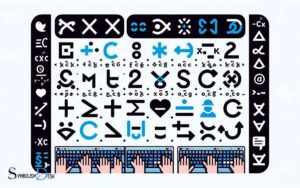Concrete Pictorial and Symbolic Math: Visual Aids!
The Concrete Pictorial Symbolic (CPS) approach in mathematics is a progressive teaching strategy that uses tangible objects, visual aids, and abstract symbols to enhance students’ comprehension of mathematical concepts.
This methodology is designed to make abstract math more accessible by linking it to the physical world, thereby promoting better understanding and retention.
The CPS approach follows a three-step learning process:
This layered learning strategy ensures that students develop a solid grasp of math fundamentals before moving to more complex abstract reasoning.
- Example: To teach addition, students might start with actual counters (Concrete), then use drawings of the counters (Pictorial), and finally write number sentences (Symbolic).
The CPS method provides a scaffolded learning experience, making mathematics more intuitive and engaging for students.

Key Takeaway
Understanding the Concrete Pictorial Symbolic (CPS) Approach in Math
| Stage | Description | Tools/Examples |
|---|---|---|
| Concrete | Hands-on learning with tangible objects | Counters, Base-10 blocks |
| Pictorial | Representing concepts through drawings or models | Number lines, Bar models |
| Symbolic | Using mathematical symbols and notations | Equations, Algebraic expressions |
Understanding the CPS Approach
One crucial aspect of understanding the CPS approach is recognizing its foundational importance in mathematics education.
CPS, which stands for Concrete Pictorial and Symbolic, is a widely recognized pedagogical approach that emphasizes the gradual progression from using concrete manipulatives to pictorial representations and finally to symbolic notation in teaching mathematical concepts.
This approach is rooted in the idea that students build a stronger conceptual understanding of mathematical ideas when they can physically manipulate concrete objects, visualize concepts through pictures, and then transition to abstract symbolic representations.
By engaging students in hands-on activities and visual representations, the CPS approach caters to different learning styles and helps students develop a deeper understanding of mathematical concepts.
Understanding the significance of this approach is essential for educators to effectively implement CPS strategies in the classroom.
Incorporating Physical Objects
When incorporating physical objects into mathematics instruction using the CPS approach, educators can facilitate a more tangible and interactive learning experience for students.
By using physical objects such as blocks, counters, or geometric shapes, students can manipulate and visualize mathematical concepts, aiding in their understanding and retention.
The following table illustrates examples of incorporating physical objects into mathematical instruction:
| Mathematical Concept | Physical Object | Implementation |
|---|---|---|
| Addition | Counters | Use counters to demonstrate adding numbers together. |
| Geometry | Geometric Shapes | Manipulate shapes to understand properties and spatial relationships. |
| Fractions | Fraction Tiles | Use fraction tiles to visualize and compare different fractions. |
| Measurement | Rulers | Use rulers to understand the concept of length and units of measurement. |
Incorporating physical objects creates concrete experiences that can help students grasp abstract mathematical ideas more effectively.
Visual Representations for Conceptualization
To enhance students’ understanding of mathematical concepts, visual representations play a crucial role in facilitating the conceptualization of abstract ideas previously explored through the incorporation of physical objects.
Visual representations, such as diagrams, charts, and models, provide a bridge between concrete experiences and abstract mathematical concepts.
They enable students to visualize and comprehend complex mathematical ideas, making connections between tangible experiences and theoretical concepts.
By using visual representations, students can develop a deeper understanding of mathematical principles, leading to improved problem-solving skills and critical thinking abilities.
These visual aids also cater to different learning styles, ensuring that all students have the opportunity to grasp mathematical concepts effectively.
As students become proficient in interpreting visual representations, they can transition to using traditional symbols and abstract representations with greater ease and understanding.
Transitioning to Traditional Symbols
Moving from visual representations to traditional symbols in mathematical education encompasses a critical transition that consolidates students’ comprehension of abstract concepts and their application in problem-solving.
As students advance in their mathematical learning, it becomes essential for them to transition from concrete and pictorial representations to symbolic representations such as numbers, variables, and mathematical notations.
This transition allows students to bridge the gap between the visual and abstract, enabling them to manipulate and operate on mathematical expressions and equations more fluently.
It is through this progression that students develop the ability to interpret mathematical problems and express solutions using traditional mathematical symbols.
Emphasizing this transition in educational practices cultivates students’ proficiency in symbolic math, preparing them for higher-level math and real-world applications where symbolic representations are prevalent.
Enhancing Mathematical Proficiency
Throughout the progression of mathematical education, enhancing mathematical proficiency becomes increasingly essential.
To achieve this, educators and students should consider the following:
Utilizing Multiple Representations:
- Encouraging the use of concrete, pictorial, and symbolic representations can deepen understanding and improve problem-solving skills.
- Concrete: Manipulatives and physical objects.
- Pictorial: Visual representations, such as diagrams or models.
- Symbolic: Mathematical notation and symbols.
Developing Conceptual Understanding:
- Focusing on understanding the “why” behind mathematical procedures rather than just the “how” can lead to more profound comprehension and retention.
Emphasizing Real-World Applications:
- Connecting mathematical concepts to real-life situations can enhance engagement and demonstrate the practical relevance of mathematical proficiency.
Conclusion
Incorporating concrete, pictorial, and symbolic math approaches has shown to enhance students’ mathematical proficiency.
Research has found that students who use visual representations alongside traditional symbols have a deeper conceptual understanding of mathematical concepts.
In fact, a study by the National Council of Teachers of Mathematics found that 83% of students who used concrete and pictorial math approaches showed improvement in their math skills.
This approach offers a promising way to improve mathematical learning for students of all ages.






